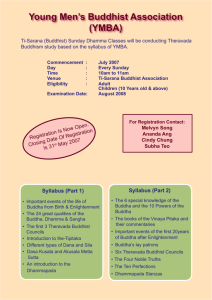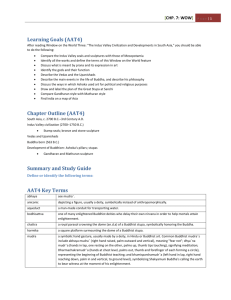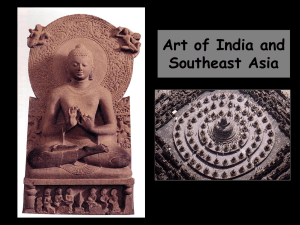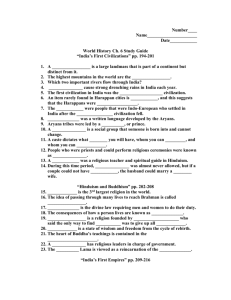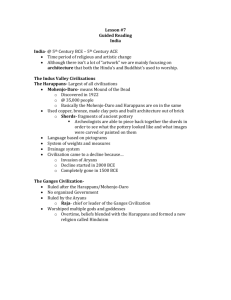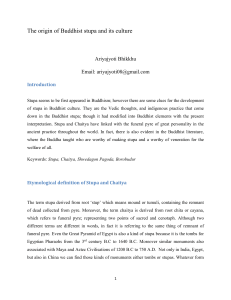Chapter 2
advertisement
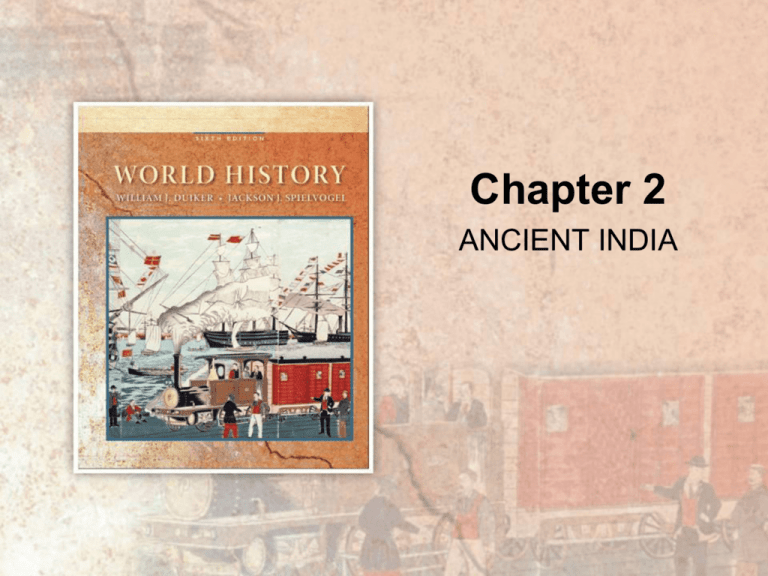
Chapter 2 ANCIENT INDIA Krishna and Arjuna preparing for battle © Chester Beatty Library, Dublin/The ridgeman Art Library Ancient Harappan Civilization This map shows the location of the first civilization that arose in the Indus River valley, which today is located in Pakistan. Mohenjo-Daro: Ancient City on the Indus One of the two major cities of the ancient Indus River civilization was Mohenjo-Daro (below). In addition to rows of residential housing, it had a ceremonial center with a royal palace and a sacred bath that was probably used by the priests to achieve ritual purity. The bath is reminiscent of water tanks in modern Hindu temples where the faithful wash their feet prior to religious devotion. Water was an integral part of Hindu temple complexes, where it symbolized Vishnu’s cosmic ocean and the concept of ritual purity. Water was a vital necessity in India’s arid climate. © William J. Duiker Mohenjo-Daro: Ancient City on the Indus One of the two major cities of the ancient Indus River civilization was Mohenjo-Daro . In addition to rows of residential housing, it had a ceremonial center with a royal palace and a sacred bath that was probably used by the priests to achieve ritual purity. The bath is reminiscent of water tanks in modern Hindu temples, such as the Minakshi Temple in Madurai pictured above, where the faithful wash their feet prior to religious devotion. © Borromeo/Art Resource, NY The Dancing Girl Relatively few objects reflecting the creative talents of the Harappan peoples have survived. This bronze figure of a young dancer in repose, 5 inches tall, is a rare metal sculpture from Mohenjo-Daro. The detail and grace of her stance reflect the skill of the artist who molded her some four thousand years ago. National Museum of India, New Delhi/The Bridgeman Art Library The Disk of Phaistos Discovered on the island of Crete in 1980, this mysterious clay object dating from the eighteenth century B.C.E. contains ideographs in a language that has not yet been deciphered. The Art Archive/Heraklion Museum/Gianni Dagli Orti Harappan Seals The Harappan peoples, like their contemporaries in Mesopotamia, developed a writing system to record their spoken language. Unfortunately, it has not yet been deciphered. Most extant examples of Harappan writing are found on fired clay seals depicting human figures and animals. These seals have been found in houses and were probably used to identify the owners of goods for sale. Other seals may have been used as amulets or have had other religious significance. Several depict religious figures or ritualistic scenes of sacrifice. © Scala/Art Resource, NY Writing Systems in the Ancient World One of the chief characteristics of the first civilizations was the development of a system of written communication. Alexander the Great’s Movements in Asia Female Earth Spirit This earth spirit, sculpted on a gatepost of the Buddhist stupa at Sanchi 2,200 years ago, illustrates how earlier representations of the fertility goddess were incorporated into Buddhist art. Women were revered as powerful fertility symbols and considered dangerous when menstruating or immediately after giving birth. Voluptuous and idealized, the earth spirit could allegedly cause a tree to blossom if she merely touched a branch with her arm or wrapped a leg around the tree’s trunk. © Atlantide Phototravel (Massimo Borchi)/CORBIS Dancing Shiva The Hindu deity Shiva is often presented in the form of a bronze statue performing a cosmic dance in which he simultaneously creates and destroys the universe. While his upper right hand creates the cosmos, his upper left hand reduces it in flames, and the lower two hands offer eternal blessing. Shiva’s dancing statues visually convey to his followers the message of his power and compassion. © William J. Duiker The Three Faces of Shiva In the first centuries C.E., Hindus began to adopt Buddhist rock art. One outstanding example is at the Elephanta Caves, near the modern city of Mumbai (Bombay). Dominating the cave is this 18-foot-high triple-headed statue of Shiva, representing the Hindu deity in all his various aspects. The central figure shows him in total serenity, enveloped in absolute knowledge. The angry profile on the left portrays him as the destroyer, struggling against time, death, and other negative forces. The right-hand profile shows his loving and feminine side in the guise of his beautiful wife, Parvati. © Charles & Josette Lenars/CORBIS. The Buddha and Jesus As Buddhism evolved, transforming Siddhartha Gautama, known as the Buddha, from mortal to god, Buddhist art changed as well. Statuary and relief panels began to illustrate the story of his life. In the frieze shown on the left, from the second century C.E., the infant Siddhartha is seen emerging from the hip of his mother, Queen Maya. Although dressed in draperies that reflect Greek influences from Alexander the Great’s brief incursion into northwestern India, her sensuous stance and the touching of the tree evoke the female earth spirit of traditional Indian art. © William J. Duiker. The Buddha and Jesus This is a Byzantine painting depicting the infant Jesus with his mother, the Virgin Mary, dating from the sixth century C.E. Notice that a halo surrounds the head of both the Buddha and Jesus. The halo—a circle of light— is an ancient symbol of divinity. In Hindu, Greek, and Roman art, the heads of gods were depicted as emitting sunlike divine radiances. Early kings adopted crowns made of gold and precious gems to symbolize their own divine authority. © Erich Lessing/Art Resource, NY The Stupa at Sarnath © age fotostock/SuperStock Sanchi Gate and Stupa Constructed during the reign of Emperor Ashoka in the third century B.C.E., the stupa at Sanchi was enlarged over time, eventually becoming the greatest Buddhist monument on the Indian subcontinent. Originally intended to house a relic of the Buddha, the stupa became a holy place for devotion and a familiar form of Buddhist architecture. Sanchi’s four elaborately carved stone gates, each over 40 feet high, tell stories of the Buddha set in joyful scenes of everyday life. Christian churches would later similarly portray events in the life of Jesus to instruct the faithful. © SuperStock The Empire of Ashoka Ashoka, the greatest Indian monarch, reigned over the Mauryan dynasty in the third century B.C.E. This map shows the extent of his empire, with the location of the pillar edicts that were erected along major trade routes. The Lions of Sarnath Their beauty and Buddhist symbolism make the Lions of Sarnath the most famous of the capitals topping Ashoka’s pillars. Sarnath was the holy site where the Buddha first preached, and these roaring lions echo the proclamation of Buddhist teachings to the four corners of the world. The wheel not only represents the Buddha’s laws but also proclaims Ashoka’s imperial legitimacy as the enlightened Indian ruler. © Sarnath, Uttar Pradesh, India/The Bridgeman Art Library Carved Chapels Carved out of solid rock cliffs during the Mauryan dynasty, rock chambers served as meditation halls for traveling Buddhist monks. Initially, they resembled freestanding shrines of wood and thatch from the Vedic period but evolved into magnificent chapels carved deep into the mountainside, such as this one at Karli. © age fotostock/SuperStock Carved Chapels Working downward from the top, the stonecutters removed tons of rock while sculptors embellished and polished the interior de´cor. Notice the rounded vault and multicolumned sides reminiscent of Roman basilicas in the West. This style would reemerge in medieval chapels such as the one shown here in southern France. © Abbey of Saint-Philibert, rance//Giraudon/The Bridgeman Art Library Symbols of the Buddha Early Buddhist sculptures referred to the Buddha only through visual symbols that represented his life on the path to enlightenment. In this relief from the stupa at Bharhut, carved in the second century B.C.E., we see four devotees paying homage to the Buddha, who is portrayed as a giant wheel dispensing his ‘‘wheel of the law.’’ © William J. Duiker
